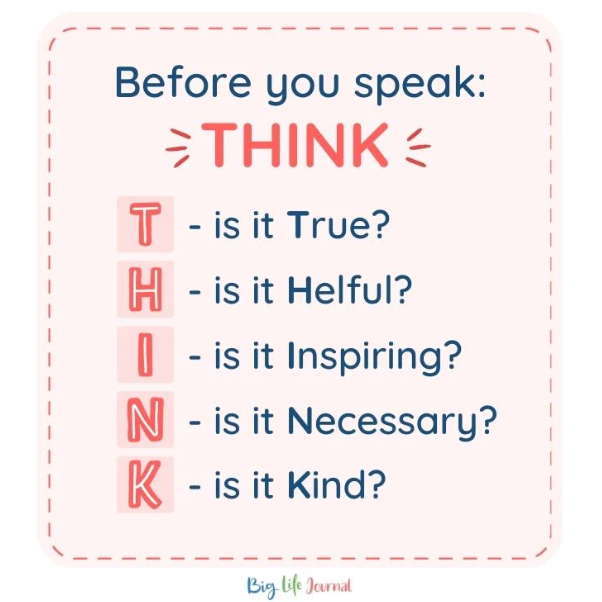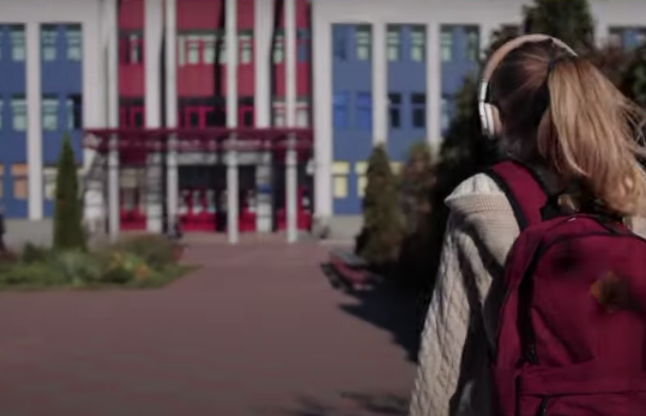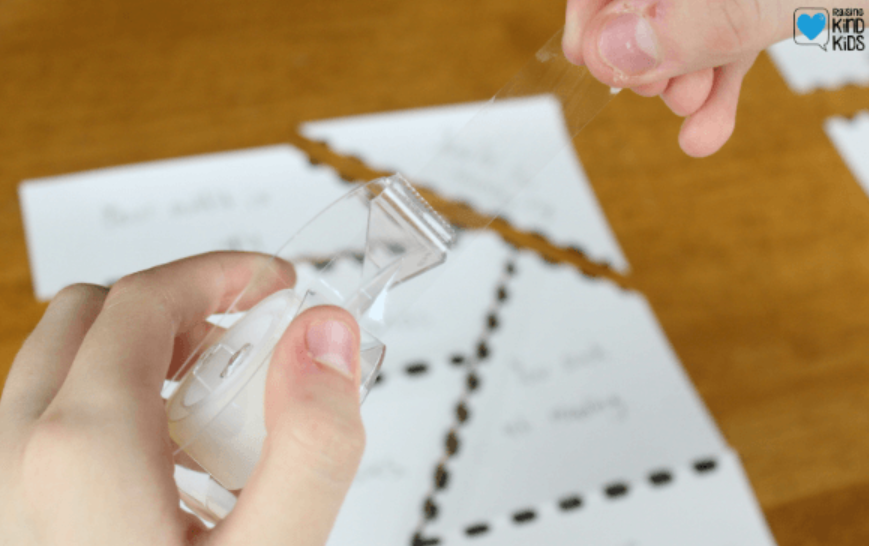When you’re about to speak, there’s a phrase you should keep in mind – “think before you speak”, especially in a classroom setting. T.H.I.N.K. stands for: Truthful, Helpful, Inspiring, Necessary, and Kind. This acronym means taking time to think through what you want to say and how it might affect someone else. Being aware of their words can help learners avoid hurtful statements, conflict, and misunderstandings. Let’s practice it with some fun, interactive activities!
1. THINK Classroom Banner
Creating a THINK banner will help students learn the difference between hurtful and helpful statements in a fun, visual way! Each day focuses on a different letter from “think”. Simply write it out, discuss it, and hang it up. By the end of the week, students will have understood the full phrase.
Learn More: Education.com
2. Print-and-Go Lesson Plan
This printable poster is here to remind you that before you speak. Teachers can print and post this in the classroom or print one for each student to keep in their class binder to serve as a close-proximity visual reminder for students.
3. Short Story for K-3 Students

This short story teaches K-3 students the importance of thinking before speaking and reinforces kindness. It helps children apply the lessons from stories to their lives.
Learn More: Kids World Fun
4. TEDx Talk Lesson for Kids
This video presentation would be perfect for middle school & high school students. They’ll easily grasp the concept of “conscious communication” in conversational situations, i.e., how to think before they speak.
Learn More: TEDx Talks
5. Wrinkled Heart Activity Using Crumpled Paper

This crumpled paper activity is great for demonstrating the effects that words can have on others. Crumpling and then unfolding a piece of paper visually represents how words can hurt someone and why it’s important to think before speaking.
Learn More: Ripple Kindness
6. Examine Social Media Posts

Challenge your students to assess social media posts against the T.H.I.N.K guidelines and record their results. Discuss whether the posts should have been shared at all.
Learn More: Big Life Journal
7. Analyze “The Boy Who Cried, Wolf
“The Boy Who Cried Wolf” is a classic teaching tool for imparting the importance of truth and using the T.H.I.N.K criteria to evaluate consequences before taking action or speaking.
Learn More: Buddy Son Storytime
8. Hmm, Should I Say That?
“Hey, you’re bad at math.” Whoa, let’s back up! A cartoon teenager communicates the importance of using mindful speech and being considerate of our words in an understandable and relatable way, especially in social situations.
Learn More: Kid Youniversity
9. Think It or Say It Premium Printable Lesson

These fabulous scenario sorting worksheets help upper elementary students decipher if comments should be said aloud or kept as a thought. This interactive activity will be sure to have a huge impact on your student’s perception of their own words.
Learn More: Teachers Pay Teachers
10. Pause + Play Activity for Active Students
Suitable for 5th-grade students and above, this video teaches students to “press pause” and listen to their audience before speaking, to avoid saying something regrettable. Students can practice as a role-playing activity.
Learn More: Orai – AI Speech Coach
11. Can a Band-Aid Fix It?

This lesson on kindness will help you teach empathy. Cut out a silhouette of a person from construction paper. Have students write negative comments on the limbs and then tear them off. Tape the limbs back together with band-aids. Reflect & discuss how it would feel to be torn apart.
Learn More: Words On a Limb
12. Short Video Series for Middle/High Schoolers

This series of short video clips featuring middle and high-school-aged students emphasize the importance of being an ally to someone who is being bullied. The series also provides ways to intervene by thinking before you say/do something that will cause emotional or physical harm.
Learn More: StopBullying.gov
13. Time Out And Think
Taking a break allows children to think before speaking or acting, learning how to respond appropriately, reset, and regain composure. In a group setting, have students practice simple activities like counting to ten, reciting the alphabet, or taking a few minutes away from the situation to employ these strategies.
Learn More: Sandbox-Learning.com
14. Damaged Relationship Activity

This activity is perfect for teaching students to be mindful of their words. Students will write unkind phrases, tear off an insult one at a time, and repair the relationship by brainstorming solutions. Tape the pieces back together and discuss if the relationship has been strengthened or weakened.
Learn More: Coffee and Carpool
15. Create a Classroom Bulletin Board

This bulletin board activity is great to kick-start the upcoming school year and reinforce positive communication skills. Using the prompts provided, students can engage in small group conversational tasks to decide what should & shouldn’t be said.
Learn More: School Bulletin Boards
16. Think Before You Post on Social Media

It’s easy to hide behind the keyboard and say whatever you want. Either as a whole class or in small groups, engage your students in analyzing this article that encourages learners to think before posting online.
Learn More: Honey and Lime
17. Cool Your Cookies: Breathing Exercises
Mindfulness Maya highlights that words can cause just as much pain as a physical injury in a fun, mental activity. She demonstrates how to “cool your cookie” by taking a moment to breathe and think before you speak, which will, in turn, have long-lasting impacts on students and relieve feelings of worry.
Learn More: Mindfulness Maya
18. Craft a Mouth to Teach Helpful Statements

Planning lessons don’t need to be a tedious task- a craft activity can help kids learn to think before they speak by role-playing scenarios. Making a paper face with a movable tongue is an engaging way to teach this lesson.
Learn More: Islam from the Start
19. Fill-in-the-Blank Printable Worksheet
This pre-made digital activity can help students recite THINK and comprehend the need for careful consideration of their words before speaking. Participating in manual-visual tasks, such as writing down concepts, enables them to create a stronger, more meaningful connection with the idea.
Learn More: Teachers Pay Teachers
20. The Toothpaste Activity

Once you’ve said something hurtful, it’s nearly impossible to undo the damage. It’s like trying to shove toothpaste back into the tube; regardless of how much you try, it simply won’t fit. This activity highlights thinking before saying something that might upset someone else.
Learn More: Spell Outloud